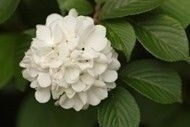 (MCT)—The Chinese snowball viburnum has a lot going for it: Virtually no insect or disease pressures, 12-foot height, spectacular glistening white blossoms, and cut flowers by the buckets. This makes this heirloom that’s strutting its stuff right now in the South an absolute winner and a must-have plant in the zone 6-9 gardens.
(MCT)—The Chinese snowball viburnum has a lot going for it: Virtually no insect or disease pressures, 12-foot height, spectacular glistening white blossoms, and cut flowers by the buckets. This makes this heirloom that’s strutting its stuff right now in the South an absolute winner and a must-have plant in the zone 6-9 gardens.
Don’t get me wrong — I love native viburnums, like the Southern arrowood, and all they have to offer as a wildlife habitat for feeding birds and butterflies. This import from China, however, has stood the test of time and has to be high on the list of companion plants for spring-blooming trees and shrubs.
The Chinese snowball is known botanically as Viburnum macrocephalum and is actually related to honeysuckle. It is for sale usually in small quantities, rarely meeting demand – perhaps because it does get large, meaning today’s small urban landscapes usually only have room for one or possibly two of these.
The snowball viburnum produces 6- to 8-inch glistening white blossoms. A close examination shows the bloom is really made of dozens of 1-inch florets. The blossoms almost resemble a cheerleader’s pom-poms. While three or four flowers would make a dramatic statement, know that the Chinese snowball produces them by the dozens. It might make you wonder how a plant can support all of those huge hydrangea-like blossoms.
The Chinese snowball is a large shrub or small tree, well suited for large gardens where it can be enjoyed from a distance. It can reach 10 feet tall in five or six years, pushing 15 feet plus in the south. They are so prized that you often find them standing alone in the middle of the landscape. While this shows off your love and perhaps their beauty it really deserves to be planted as part of a shrub border with colorful contrasting partners.
Aesthetically speaking, I prefer to plant it behind or in combination with azaleas. It performs best in the same moist but well-drained shady environment where you would grow an azalea, and it makes an incredible companion plant, usually blooming in sequence with the Southern Indica azaleas. At the Columbus Botanical Garden we have ours not with azaleas but in a bed partnered with perennials like the native Stokes asters, lavender obedient plants and spring bulbs.
Prepare a bed for both azaleas and viburnums by working in 3 to 4 inches of organic matter like compost or humus. Another good option is to plant on raised beds and bring in prepared landscape planting mixes available at most garden centers.
Dig your planting hole two to three times as wide as the rootball but no deeper, planting at the same depth it is growing in the container. As you prepare the soil, incorporate 2 pounds of 5-10-5 fertilizer per 100 square feet of bed space. Feed about four weeks after planting with a slow-release fertilizer like a 12-6-6 or balanced 8-8-8 at a rate of 1 pound for the same area.
There will be a lot of choices when you shop this spring at your garden center. I hope you will look for viburnums, both the native and flashy imported Chinese snowball.
Norman Winter is executive director of the Columbus Botanical Garden, Columbus, Ga., and author of “Tough-as-Nails Flowers for the South” and “Captivating Combinations Color and Style in the Garden.”
Distributed by MCT Information Services










